In Wonderland
Last weekend, I attended the incredible art exhibit In Wonderland: The Surrealist Adventures of Women Artists in Mexico and the United States now on view at the L.A. County Museum of Art.
I’ve been noodling around with this blog post ever since, trying to capture in words the feelings the images contained in this exhibit have evoked in me. Wonder. Excitement. Awe. Inspiration.
I’m a writer, I should be able to do better than that, I know!
I have no background in art history, so the context of the Surrealist movement is a bit outside my study (something I intend to change) — I had no idea how initially masculine the art movement had been. But it seems even stuffy André Breton, the founder of the movement, eventually came around to recognizing the essential contributions of women to Surrealism.
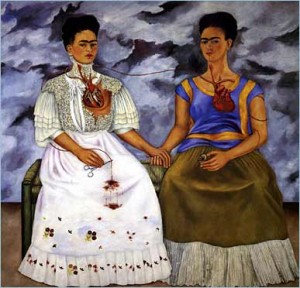
The big attraction of In Wonderland is Frida Kahlo. Of course, everyone knows who Frida Kahlo is now; her self-portraits are world-famous, and rightly so. (I highly recommend the film Frida with Salma Hayek, which is a highly visual and moving look at her life, work, and tumultuous relationship with Diego Rivera). In Wonderland has two of Frida’s most well known pieces: The Two Fridas and Self-Portrait with Thorn Necklace and Hummingbird. (I have a cheesy, lenticular 3D magnet version of this one at home. I love it.)
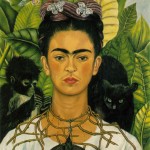
Both paintings resonate strongly with me, and seeing them in person was heady to say the least. The Two Fridas contain a pair of nearly life-size self-portraits who seem to share symbiotic secrets with one another across dripping, arterial conduits. It’s Frida at her best. The Frida with the thorn necklace is like one of those paintings in a haunted house, except in reverse. Instead of the life-like eyes following you around the room, Frida’s eyes always look away from you.
But for me, Frida is not the star of the show at this exhibit. It’s hard to report my responses to every single artist (and they all affected me, to be sure) so I’ll try and name a few of my favorites whose body of work truly took my breath away.
I love Remedios Varo, a Spanish-Mexican painter, for her delicately rendered explorations of architecture, alchemy, and allegory such as Woman Departing from the
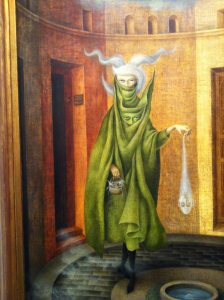
Psychoanalyst’s Office, Creation of the Birds, Harmony, and Celestial Pablum. Varo’s work is deeply affecting, with intricately crafted devices operated by pale, almost elfin, figures against fantastical landscapes and chambers. Her paintings are full of mysterious narratives, which is perhaps why I am drawn to them so much.
American Sylvia Fein paints fantastic, fairy-tale portraits with a phenomenal attention to detail. Her figures are self-assured, confident in settings painted with almost a casual, messy blur. But look closely and the landscape is dotted with tiny faces, birds, bugs, and individually rendered flowers and blades of grass. Varo’s landscapes are cerebral, metaphorical, but Fein’s seem like places I’ve been. I
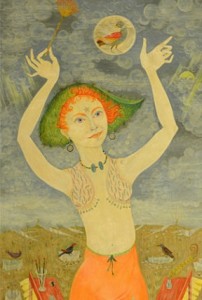
particularly like The Tea Party, Ladies with Many Faces, and especially the colorful The Lady Magician.
But the artist who truly took my breath away was the multi-disciplined Leonora Carrington. Born in Britain, she lived most of her life in Mexico, submerged in the vibrant Surrealist art community there. I had read a few of her stories (she was a writer, too) before the show, but had never really seen her art. From the moment I saw her self-portrait Inn of the Dawn Horse (where Carrington and a hyena have traded eyes) I was hooked.
Carrington’s paintings superficially resemble her friend Varo’s: many feel like alchemical treatises from medieval or Renaissance manuscripts. Unlike Varo’s, though, which focus mainly on single figures, Carrington’s paintings are crammed with shamans and witches, alchemists and wizards, devils and angels, and curious, leering translucent spirits that seem half-arcane symbol and half-smoke. It’s enough to give you nightmares and dreams for a lifetime. It’s rich, wonderful stuff. I especially loved The Chrysopeia of Mary the Jewess,
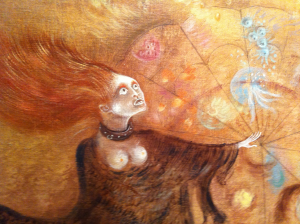
The Juggler, The Return of Boadicea, and Green Tea. The buried, shrouded figures in the underworld of the latter painting outright give me the creeps. In a good way.
Carrington didn’t stop with painting, though. She was an avid crafter, what we might call a “maker” today. Her strange masks and dolls (particularly Red Mask and Delicate Fly) are not only wondrous artifacts themselves, but you often see her work showing up in the photographic art of fellow Surrealists like Kati Horna. Carrington posed in photos as well: the disturbing Ode to Necrophilia by Horna contains Carrington as partially glimpsed nude in the bed of a “dead” person. (This series is also on show at LACMA.)
I’ll be grappling with the images in Carrington’s art for some time to come, and I’ll definitely be seeking out more of her fiction.
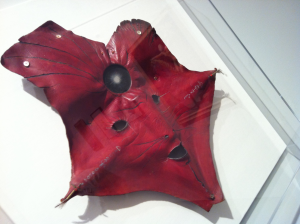
Other artists intrigued me, though not not with every piece on display. I was struck by certain works from Helen Lundeberg, Alice Rahon, Dorothea Tanning, Bridget Tichenor, Kay Sage, and Rosa Rolanda. Lee Miller and Francesca Woodman’s photos could easily command a show of their own.
This is the kind of show that thrills me, that makes me glad to be connected to my creative self. I’m not much of painter or sculptor, but the kinship I feel to these women, and the bond of art that we share fills me with the urge to get out and create more. (It was also a great joy to attend the show with fellow creatives Carol, Galen, Tracie, and Reg. you can see some of the art we made over here.)
I came away vowing to reconnect with the visual art side of myself, and to take more chances with my writing. Good goals, though they will be lifelong processes, I think.
If you live anywhere near the L.A. area, you’ve got to go see this show before it closes May 6. I’m planning on going at least once more to catch the things I missed.
